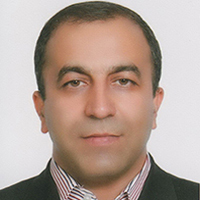Verification SEBAL and Hargreaves - Samani Models to Estimate Evapotranspiration by Lysimeter Data
Author(s):
Abstract:
Introduction
Evapotranspiration (ET) is an important component of the hydrological cycle, energy equations at the surface and water balance. ET estimation is needed in various fields of science, such as hydrology, agriculture, forestry and pasture, and water resources management. Conventional methods used to estimate evapotranspiration from point measurements. Remote sensing models have the capability to estimate ET using surface albedo, surface temperature and vegetation indices in larger scales. Surface Energy Balance Algorithm for Land (SEBAL) estimate ET at the moment of satellite path as a residual of energy balance equation for each pixel. In this study Hargreaves-Samani (HS) and SEBAL models ET compared to an alfalfa lysimeter datas, located in Shahrekord plain within the Karun basin. Satellite imageries were based on Landsat 7 ETM sensor datas in seven satellite passes for path 164 and row 38 in the World Reference System, similar to lysimeter sampling data period, from April to October 2011. SEBAL uses the energy balance equation to estimate evapotranspiration. Equation No. 1 shows the energy balance equation for an evaporative surface: λET=RnGH [1]In this equation Rn, H, G and λET represent the net radiation flux input to the surface (W/m2), Sensible heat flux (W/m2), soil heat flux (W/m2), and latent heat of vaporization (W/m2), respectively. In this equation the vertical flux considered and the horizontal fluxes of energy are neglected. The above equation must be used for large surfaces and uniformly full cover plant area. SEBAL is provided for estimating ET, using the minimum data measured by ground equipment. This model is applied and tested in more than 30 countries with an accuracy of about 85% at field scale, and 95 percent in the daily and seasonal scales. In Borkhar watershed (East of Isfahan, IRAN) ASTER and MODIS satellite imageries were used for SEBAL to compare Penman-Monteith model. Results showed that estimated ET of SEBAL were about 20% less than sugar beet ET and about 15% more for maize ET by Penman-Monteith. He concluded the differences may be due to the limited number of satellite imageries which extrapolated ET through the entire growth period and the data obtained from the weather station far from 24 km in the studied area. In another study at Zayanderud Basin, the different irrigation networks were examined using Landsat 7 imageries to increase the spatial resolution of NOAA satellite to determine the energy balance components and actual evapotranspiration. In this study, data from a lysimeter to a depth of 2.5 m and a diameter of 3 meters planted with alfalfa in the Chahar-Takhteh agricultural research station (Agricultural and natural resources research center of Shahrekord, IRAN) was used. The lysimeter (LYS_REF) located in the in the middle of 25 × 40 m (1000 square meter) alfalfa cultivated farm, surrounded by other planted area. The lysimeter used to measure the reference evapotranspiration (ETr) and around alfalfa was used as cold pixels.
Materials And Methods
This study was conducted to evaluate SEBAL and Hargreaves-Samani estimated ET models against evapotranspiration measured by lysimeter within the Shahrekord plain. Meteorological data required for a period of 185 days (according to the lysimeter data period) includes minimum and maximum relative humidity (RHmax and RHmin), maximum and minimum air temperature (Tmax and Tmin), wind speed at two meters (U2), precipitation, evaporation rate, sunshine hours, air pressure and dew point temperature obtained from a weather station nearby lysimeter. In order to assess reference evapotranspiration (ETr) models, statistical indices such as the coefficient of determination (R2), mean absolute error (MAE), mean bias error (MBE), root mean square error (RMSE) and index of agreement (d) were used.Results And Discussion
The results showed that RMSE, MAE and MBE for SEBAL model over the lysimeter data were 1.782, 1.275 and -0.272 mm/day and 0.700 for the d index, respectively. Similar indices for the Hargreaves-Samani model were 1.003, 0.580 and 0.290 mm/day and 0.917 for the d index. For HS model results show that RMSE, MAE and MBE values were 0.813, 0.477 and 0.206 mm/day, and 0.930 for the index of d, during the entire growing period (185 days).Conclusion
However, results showed that the efficiency and reliability of the SEBAL model by processing satellite visible, near infrared and thermal infrared bands. The need for irrigation water requirements and ET estimation are noteworthy, during the growth of various plants, which vary and thus the complete time series of satellite imageries is required to estimate the total and annual evapotranspiration.Keywords:
Language:
Persian
Published:
Journal of water and soil, Volume:30 Issue: 2, 2016
Pages:
367 to 376
magiran.com/p1568313
دانلود و مطالعه متن این مقاله با یکی از روشهای زیر امکان پذیر است:
اشتراک شخصی
با عضویت و پرداخت آنلاین حق اشتراک یکساله به مبلغ 1,390,000ريال میتوانید 70 عنوان مطلب دانلود کنید!
اشتراک سازمانی
به کتابخانه دانشگاه یا محل کار خود پیشنهاد کنید تا اشتراک سازمانی این پایگاه را برای دسترسی نامحدود همه کاربران به متن مطالب تهیه نمایند!
توجه!
- حق عضویت دریافتی صرف حمایت از نشریات عضو و نگهداری، تکمیل و توسعه مگیران میشود.
- پرداخت حق اشتراک و دانلود مقالات اجازه بازنشر آن در سایر رسانههای چاپی و دیجیتال را به کاربر نمیدهد.
In order to view content subscription is required
Personal subscription
Subscribe magiran.com for 70 € euros via PayPal and download 70 articles during a year.
Organization subscription
Please contact us to subscribe your university or library for unlimited access!



